There are increasingly frequent reports of teachers behaving like political activists in their classrooms. An Advanced Placement teacher in Sacramento, California, was videotaped professing support for Antifa and admitting that his goal was to indoctrinate students so that they “turn into revolutionaries.”REF Classrooms in Los Angeles were decorated with signs that read “F*** The Police” and “F*** AmeriKKKa.”REF In the Saint Louis area, e-mails were leaked in which district school administrators conspired to hide controversial lesson plans from parents.REF A public school teacher in Blacksburg, Virginia, released a video describing the school district’s student discipline system as one of white supremacy.REF
Granted, there are more than 3.2 million public school teachers in the United States. Are these anecdotes best understood as outliers, or do they represent a meaningful pattern of political activism among K–12 educators? One way to answer this question is to ask a nationally representative sample of teachers about their views on a variety of political topics. Learning what teachers think about issues related to diversity, equity, and inclusion (DEI)—and marking where teachers fall on these issues relative to the public—is the primary purpose of this Backgrounder. There have been other surveys about critical race theory, the 1619 Project, and other DEI issues, but rarely have K–12 teachers been asked to give their opinions.
Another motivating factor for this Backgrounder is to learn whether well-documented activism in higher education is also prevalent in K–12 education. In a separate report, we show that universities have invested heavily in DEI bureaucrats.REF These administrators appear to make no positive contribution to campus climate and may be better understood as enforcers of narrow ideological goals. Of course, students and parents have many choices about where to enroll for college. In the realm of K–12 schooling, parents are rarely so fortunate. As such, it is essential to understand the political views of teachers in K–12 schools.
For parents who are worried about increasing political activism in the classroom, the results of this survey are something of a mixed bag. For instance, parents may be alarmed to learn that more than half of teachers agreed with the statement that white supremacy is a major problem in the United States and that this supremacy has been ingrained in America since the Founding. But, overall, responses suggest that teachers are not extremely ideological. In most cases, teacher views are moderate or slightly left of center. The average teacher response was consistently more moderate than that of the average liberal in the nationally representative sample. We find little evidence that a large percentage of teachers are systemically imposing a radical political agenda in K–12 classrooms. We discuss implications of these results—including the possibility that teachers may often be allies, rather than opponents, of parents concerned about critical race theory, the 1619 Project, and other divisive ideologies in public schools.
Past Research
Only a few surveys focused on the opinions of K–12 teachers and school leaders on political issues, particularly on topics related to DEI. The limited existing evidence suggests that teachers have moderate or slightly liberal views.
For instance, a fall 2017 nationally representative survey of K–12 teachers and administrators showed that a plurality of respondents (43 percent) describe themselves as moderate, compared to 29 percent who selected liberal, and 27 percent who selected conservative.REF By a 52-to-43 margin, teachers also expressed the opinion that black and Hispanic students have the same educational opportunities as white students, further supporting the notion of moderate political views. However, two pieces of information from the survey suggest more ideologically liberal views. First, teachers were significantly more likely to report voting for Hillary Clinton (50 percent) than Donald Trump (29 percent) in 2016. Second, more than two-thirds of respondents stated that the teachers union in their school district does a good job of representing their political views.
A 2021 Braun Research poll commissioned by Heritage Foundation analysts asked more than 1,000 parents and more than 1,000 school teachers a series of questions about civics education.REF Parents and teachers overwhelmingly agreed that more class time should be devoted to civics instruction. Forty-four percent of teachers said they were familiar with critical race theory (CRT), compared to 35 percent of parents. Neither group had a favorable view of CRT, with only 30 percent of teachers and 26 percent of parents indicating that they view it in a positive light.
Democratic parents were 16 percentage points more likely than Republican parents to be satisfied with the current civics instruction in their child’s school. Pluralities of parents (31 percent) and teachers (39 percent) indicated that students were becoming more divided about civics topics. Moreover, pluralities of parents (34 percent) and teachers (38 percent) indicated that the classroom atmosphere is less civil today than in the past. Broadly speaking, this survey suggests that teachers are aligned with parents on issues of civics instruction and opinions on CRT.
A 2020 Braun Research poll, also commissioned by Heritage analysts, compared the responses of parents to those of public school board members on a series of controversial political topics.REF Overall, school board members appeared more ideologically conservative than parents. For example, school board members were 10 percentage points less likely than parents to believe that schools should use instructional material based on the idea that slavery is at the center of America’s national narrative. Parents were more than twice as likely as school board members to support a curriculum that says that America’s founding ideals of liberty and equality were false. Only 16 percent of school board members want students to be taught that the birth of America was 1619—the year in which African slaves first landed in the English colonies—compared to 33 percent of parents. Moreover, some 55 percent of parents, compared to 39 percent of school board members, agreed that educators must acknowledge the existence of white supremacy culture as a primary root cause of institutional racism, structural racism, and white privilege. To the extent that liberal activism is a problem in K–12 classrooms, this survey suggests that it is not being driven by school boards.REF
There have been a few recent polls asking about CRT, the 1619 Project, and other DEI-related topics. For example, a USA Today/Ipsos poll from summer 2021 found that 69 percent of Democrats and 27 percent of Republicans support the application of CRT in their local public school.REF A Reuters/Ipsos survey found that 44 percent of respondents are familiar with CRT, and 37 percent agreed with the principles of CRT.REF The survey found that 24 percent of Americans are familiar with the 1619 Project. But few polls have asked these questions of K–12 teachers.
The primary takeaway from these surveys is that teachers are generally moderate, school boards are generally conservative, and topics like CRT, the 1619 Project, and other DEI-related issues have relatively little support from the general public. Yet there has been little investigation into the opinions of teachers, and the research that does exist is ambiguous. The survey presented in this report can shed more light on teacher attitudes and plot those responses in comparison to self-described liberals and conservatives.
Survey Design
The survey-research firm Ipsos administered a nationally representative survey to 1,632 adults ages 18 and over. The survey was conducted on KnowledgePanel, a probability-based Web panel. The median completion time was 10.8 minutes. The survey oversampled active K–12 teachers (n=611) to provide additional statistical power, allowing inferences about this population. Responses from the general population sample (n=1021) had a margin of error of +/– 3.2 percent, and responses from the K–12 teacher sample had a margin of error of +/– 5.3 percent.
The survey instrument consisted of 25 items asking respondents about a variety of topics related to politics, CRT, and DEI, as well as demographic and background information. Weights were used to ensure that the combined sample was representative of the U.S. population. The survey was in the field for two weeks during summer 2021.
The main focus of the survey was on how teacher responses compared to self-described liberals and self-described conservatives in the general population. The general population sample was comprised of 25 percent liberals, 34 percent conservatives, and 38 percent moderates. The teacher sample was comprised of 37 percent liberals, 32 percent conservatives, and 32 percent moderates.
The 25 items were organized into three categories: (1) race and discrimination, (2) DEI, and (3) school policies. Tables 1–3 indicate the percentage of respondents who agreed with each item. For items with high variation across political ideology, Charts 1-3 show how the average respondent and the average teacher compare with liberals and conservatives in the general population.
Results
The average teacher expressed views that were marginally to the left of the average respondent, and significantly to the right of the average liberal respondent in the general population. Although teachers appear to be slightly more liberal than average, teacher views were consistently more aligned with those of the average respondent than with either major ideology. There is also some evidence that teachers in blue states—where the Democratic Party controls at least two of the State House, State Senate, and governorship—have more liberal views than teachers in red states.
Race and Discrimination. Although nearly all respondents (94 percent) indicated a desire for America to be a place where individuals are judged by the content of their character rather than the color of their skin, only 40 percent of all respondents agreed that Martin Luther King, Jr.’s vision has indeed been realized in the United States. Thirty-six percent of teachers agreed that individuals are mostly judged by the content of their character—which was twice as high as liberal respondents (18 percent).
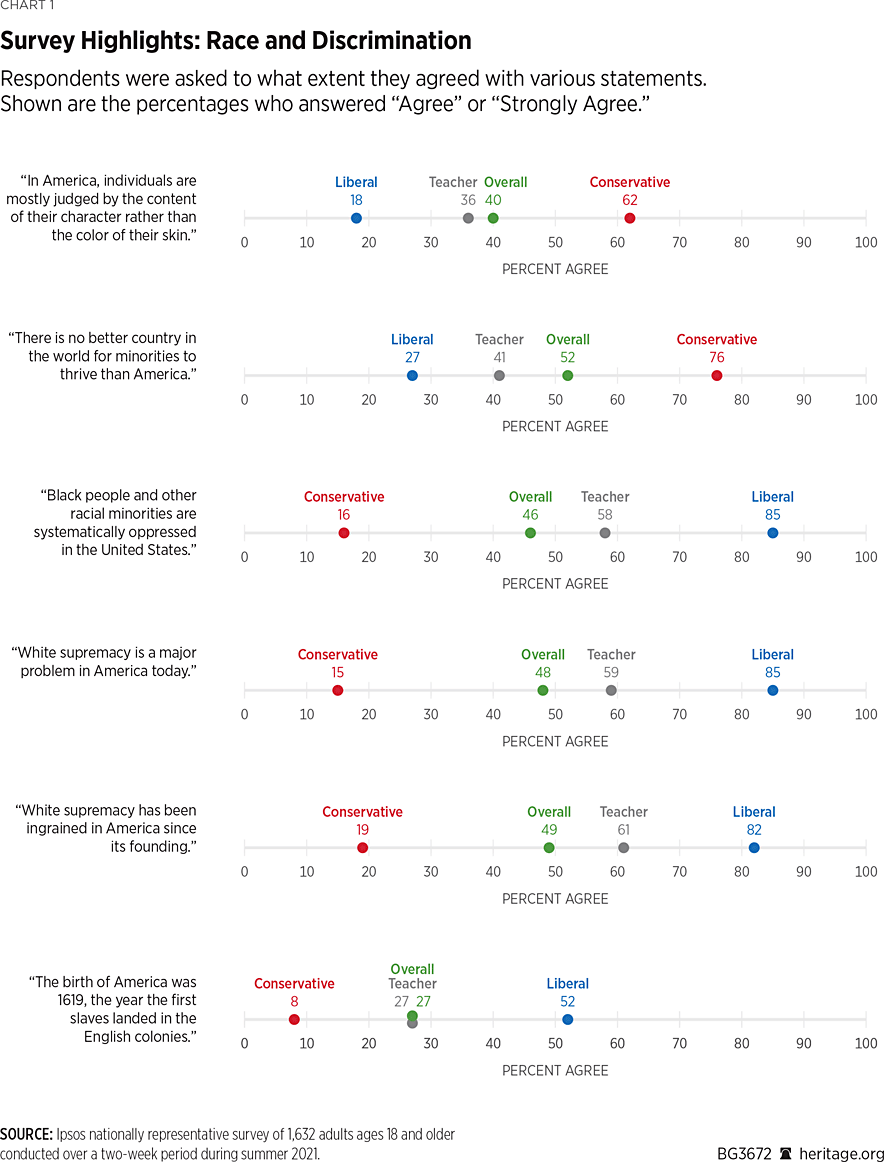
More than half of those surveyed agreed that there is no better country in the world for minorities to thrive than America. Forty-one percent of teachers agreed with this statement, compared to 27 percent of liberals and more than three-quarters of conservatives. Similarly, more than half of teachers (58 percent) agreed that black people and other racial minorities are systemically oppressed in America, which is higher than the average respondent (46 percent) but far below the average liberal (85 percent). Only 16 percent of conservatives believe that racial minorities are systemically oppressed.
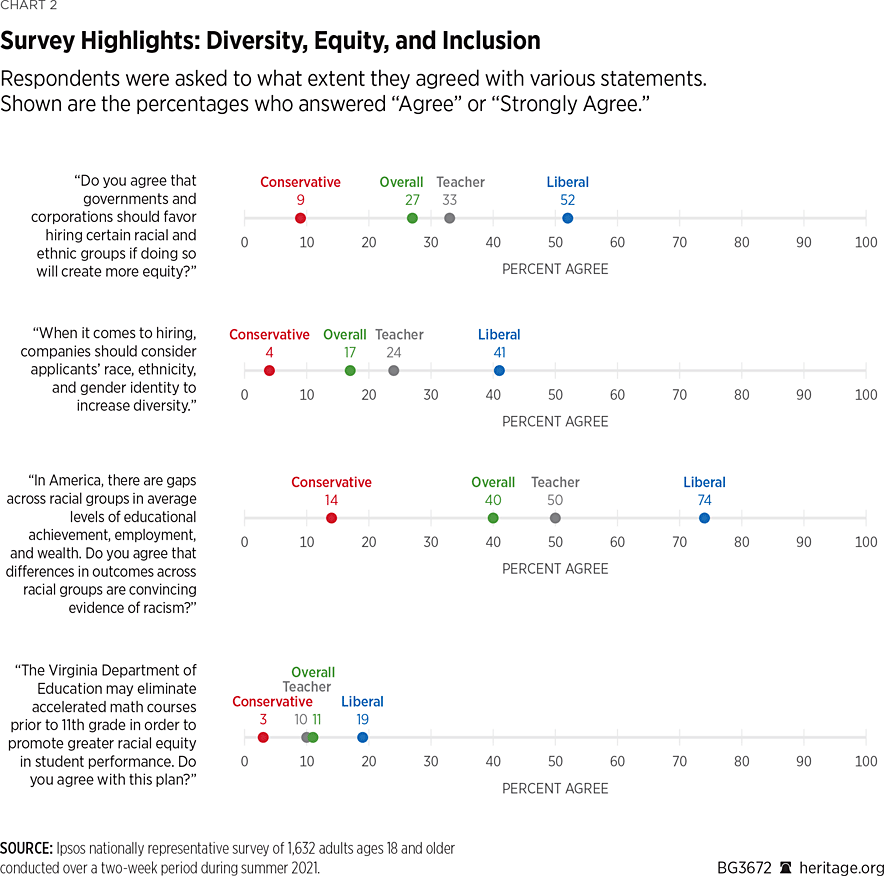
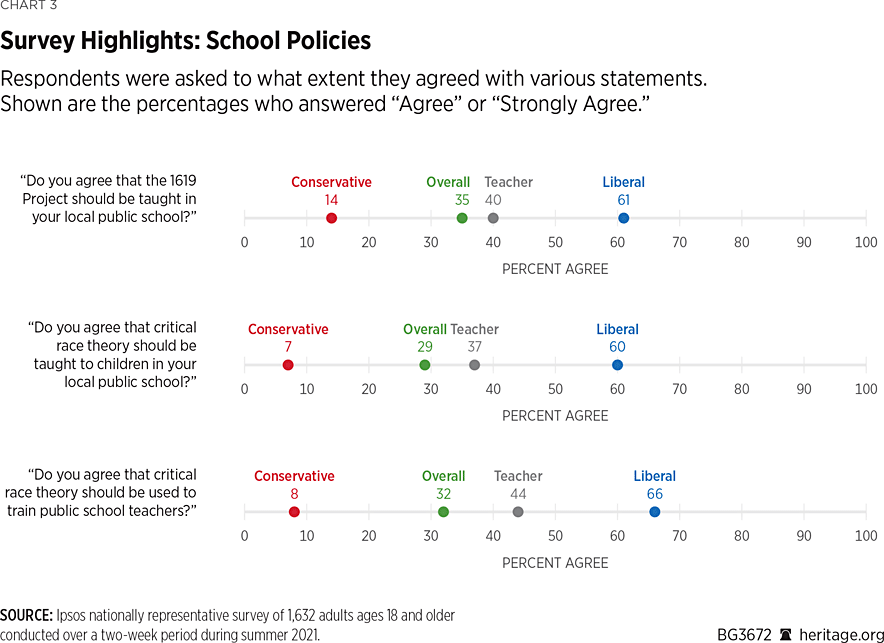
More than half of teachers agreed that white supremacy is a major problem in the United States (59 percent) and that supremacy has been ingrained in America since the Founding (58 percent). In both cases, teachers were about 10 percentage points more likely to agree than the average respondent, and more than 20 percentage points less likely to agree than the average liberal. Fewer than 20 percent of conservatives agreed that white supremacy is a major problem or that white supremacy has been ingrained since the Founding of the nation.
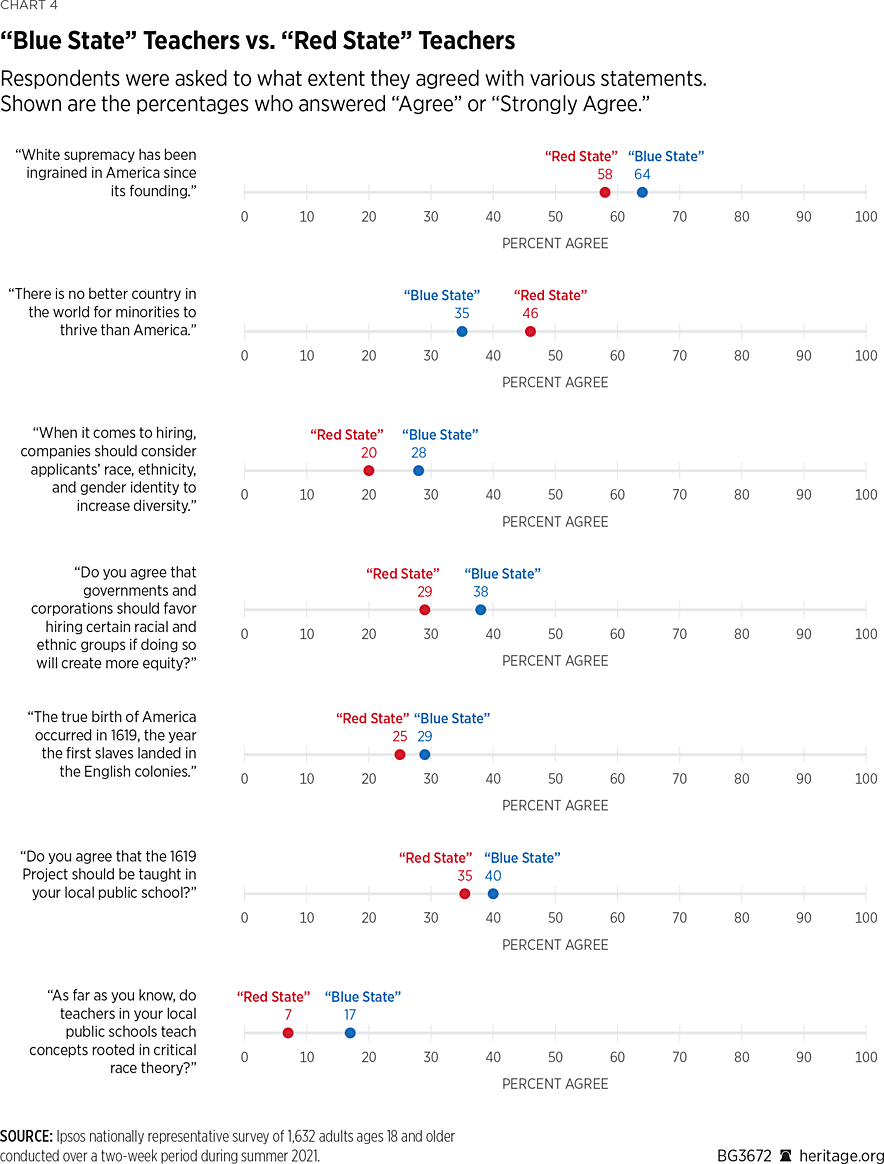
When asked if the true birth of America occurred in 1619—when the first slaves landed in the English colonies—or if the true birth of the nation occurred in 1776, teachers and the average respondent gave nearly identical responses, with only 27 percent selecting 1619. More than half of liberal respondents agreed that 1619 should be considered the true founding of America, nearly twice as many as among the teachers.
The item with the least variation in this category asked if respondents agreed with the following notion, popularized by Ibram X. Kendi: “The only remedy to past discrimination is present discrimination. The only remedy to present discrimination is future discrimination.” On average, only 10 percent of respondents agreed, with liberals marginally more likely to agree (13 percent) than teachers (11 percent) and conservatives (7 percent). See Table 1 for complete results.
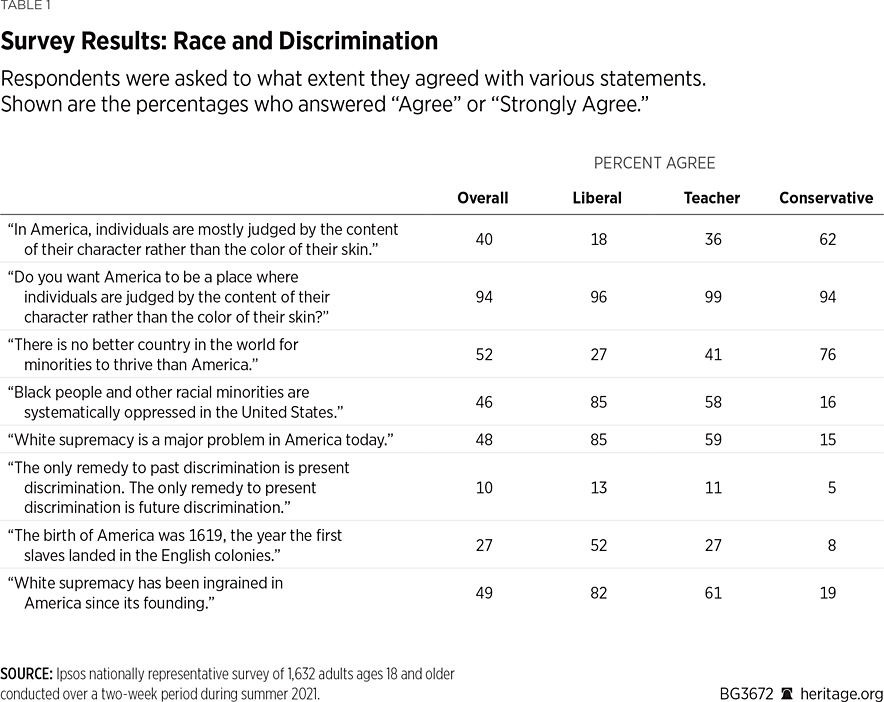
Diversity, Equity, and Inclusion. Almost all respondents, regardless of ideology, indicated a desire for America to be a melting pot where people from different backgrounds and experiences unite around common values. On six other items related to DEI, however, there were double-digit partisan differences between liberals and conservatives. Once again, teacher views were similar to those of the average respondent and more conservative than those of the average liberal. For example, only 33 percent of teachers agreed that governments and corporations should favor hiring certain groups if doing so would create more equity. This was only six points higher than the average respondent and 19 points lower than the average liberal.
Respondents were also asked whether companies should consider race, ethnicity, and gender to increase diversity, or alternatively, if companies should hire the most qualified applicants without considering these factors. Only 17 percent of respondents—and 4 percent of conservatives—agreed that companies should prioritize diversity over merit. Twenty-four percent of teachers agreed with prioritizing diversity, compared to 41 percent of liberals.
Nearly three-quarters of liberals agreed that racial differences in average levels of educational achievement, employment, and wealth are convincing evidence of racism. Fifty percent of teachers agreed, which was about 10 percentage points higher than the sample average (40 percent).
The survey also asked respondents if they agreed with a plan proposed by the Virginia Department of Education to eliminate accelerated math courses prior to 11th grade, in an effort to promote greater racial equity in student performance. Only 10 percent of teachers supported this idea, which was nearly identical to the sample average of 11 percent. Liberal respondents were nearly twice as likely as teachers to support eliminating accelerated math for the sake of equity.
Moreover, teachers were slightly less likely than liberals to support organizing school children into racial or gender-identity groups. Teachers were also marginally less likely than liberals to agree that diversity training makes people more compassionate toward others. See Table 2 for complete results.
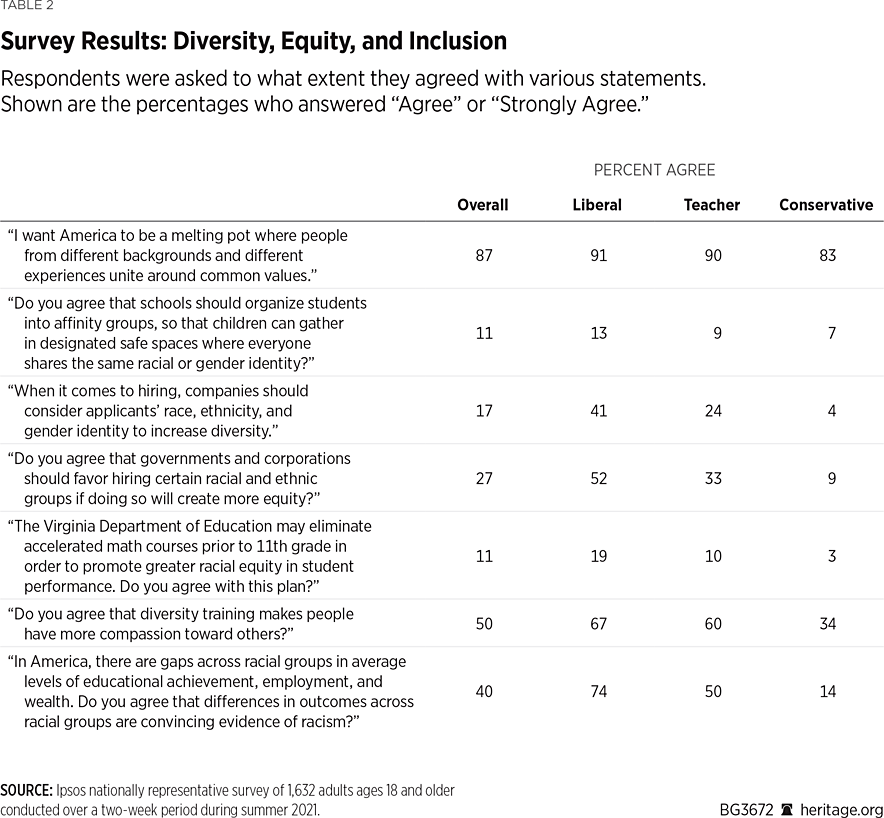
School Policies. The third category of questions solicited reactions to a series of school-related policies. Here, there were three items with large partisan differences and seven items with single-digit partisan differences. On the three items with the biggest partisan divides, teachers were closer to the average respondent than the average liberal. For instance, teachers were five percentage points more likely than the sample average, and 21 points less likely than the average liberal, to believe that the 1619 Project should be taught to children in public schools.
Similarly, teachers were eight percentage points more likely than average respondents, and 23 points less likely than liberals, to believe that CRT should be taught to children in public schools.
Sixty-six percent of liberals believed that CRT should be used to train teachers in traditional public schools, compared to only 8 percent of conservatives. The average respondent (32 percent) and teachers (44 percent) fell in the middle of the two extremes.
Although only 12 percent of teachers indicated that they think that other teachers use CRT concepts in the classroom, this was twice as high as the average respondent—only 6 percent of whom indicated that they think teachers use CRT. Overall, only a small proportion of the sample indicated that they believe the 1619 Project (2 percent) is currently being used in public schools. Overall, familiarity with CRT (43 percent) was about twice as large as familiarity with the 1619 Project (21 percent) among the average respondent. Teachers were more likely than liberals and conservatives to be familiar with CRT and the 1619 Project.
There was broad agreement that an excellent teacher can overcome challenging family circumstances (76 percent of liberals and 84 percent of conservatives). Likewise, few respondents agreed with the policy of setting a lower bar for poor students to graduate from high school because they face difficult challenges in their home—although liberals (12 percent) were four times as likely to favor this approach than conservatives (3 percent). Fewer than 10 percent of respondents agreed that defunding school resource officers—law enforcement officials responsible for crime and safety prevention in educational settings—would make schools safer. See Table 3 for complete results.
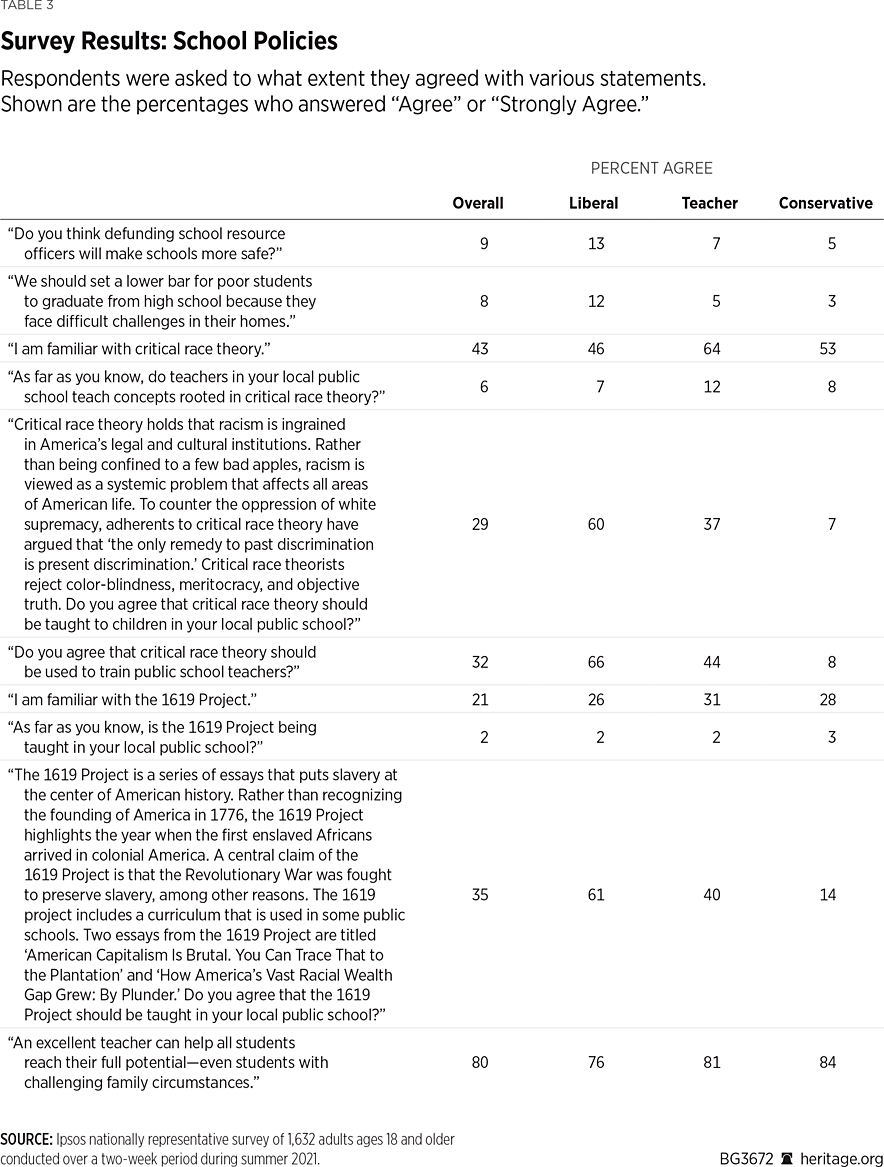
Blue Teachers vs. Red Teachers. The respondents’ state of residence was used to group teachers into two categories. Teachers who resided in a state where at least two of the House, Senate, and governorship were controlled by Democrats were classified as blue state teachers. Teachers who resided in a state where at least two of the House, Senate, and governorship were controlled by Republicans were classified as red state teachers. Nineteen states and the District of Columbia fell into the blue state category, and 31 states were in the red state category.REF Comparing responses from teachers in red and blue states sheds light on whether there were different patterns of results.
Organizing teachers into these categories revealed modest variation in responses. There were a handful of items in which blue state teachers demonstrated double-digit differences from red state teachers. (See Chart 4.) The biggest gap was evident on whether teachers believe that America is the best country in the world for minorities to thrive. Only 35 percent of blue state teachers agreed with this sentiment, compared to 46 percent of red state teachers. Seventeen percent of blue state teachers and just 7 percent of red state teachers indicated that CRT was being used in public school classrooms. Blue state teachers were nearly 10 percentage points more likely to believe that in order to promote equity, governments and companies should favor certain racial groups when hiring. Although blue state teachers were six points more likely to believe that white supremacy has been ingrained since America’s Founding, some 58 percent of red state teachers also held this view. Teachers in blue states were five percentage points more likely to believe that the 1619 Project should be taught in public schools.
Discussion
The results of this survey do not support the idea that K–12 teachers are radical activists, although conservative and moderate parents may find it disconcerting that nearly six of 10 teachers believe that white supremacy is a major problem in the United States. Overall, teachers appear somewhat left of center on many topics, but their responses were not particularly close to those of the average liberal.
When it comes to certain hot-button cultural topics, there appears to be a disconnect between the leadership of major teachers’ unions and their own members. The National Education Association made headlines when two of its state affiliates sued a stay-at-home mom for asking whether CRT was being used in her daughter’s curriculum.REF The same union passed a resolution at its annual meeting claiming that it is “reasonable and appropriate” to teach CRT and promised to help teachers “fight back against anti-CRT rhetoric.”REF Teachers union leaders may risk overplaying their hands if they continue to wade into fraught political debates—particularly given the findings of this survey that teachers are generally not in favor of using CRT in their classrooms.
Rather than radical teachers seeking to indoctrinate their local communities, our research suggests that teachers hold views that are generally reflective of the college-educated populations in which they live. Although teacher opinions tended in the liberal direction, our findings suggest that attention-grabbing headlines about Marxist history teachers are exceptions rather than the norm.
Higher levels of political activism may be found in areas with more homogenous political climates. Consistent with our findings that teachers in blue states tend to have more progressive views than teachers in red states, it should not be surprising to read stories about liberal teachers in liberal areas. Of course, it is possible that teacher activism is more prominent in liberal areas than in conservative areas—our results cannot speak to this possibility.
The major policy implication is for state legislators, school boards, and parents to restrict the growth of DEI bureaucracy, which exists not only in institutions of higher education but also in K–12 education. It is likely the professional liberal activists, not the classroom teachers, who are the driving force behind many DEI initiatives that are permeating some school districts.REF These administrative employees—who are extremely well organized, but represent a minority viewpoint—are motivated by political goals, while most classroom teachers are motivated to help students to learn.
Overall, these results could be good news for parents who are concerned about the growing influence of progressive ideology in public schools. Teachers may very well be allies, rather than opponents, in the pushback against the use of CRT and other divisive ideologies in the classroom.
Jay P. Greene, PhD, is Senior Research Fellow in the Center for Education Policy, of the Institute for Family, Community, and Opportunity, at The Heritage Foundation. James D. Paul is Director of Research at the Educational Freedom Institute.



